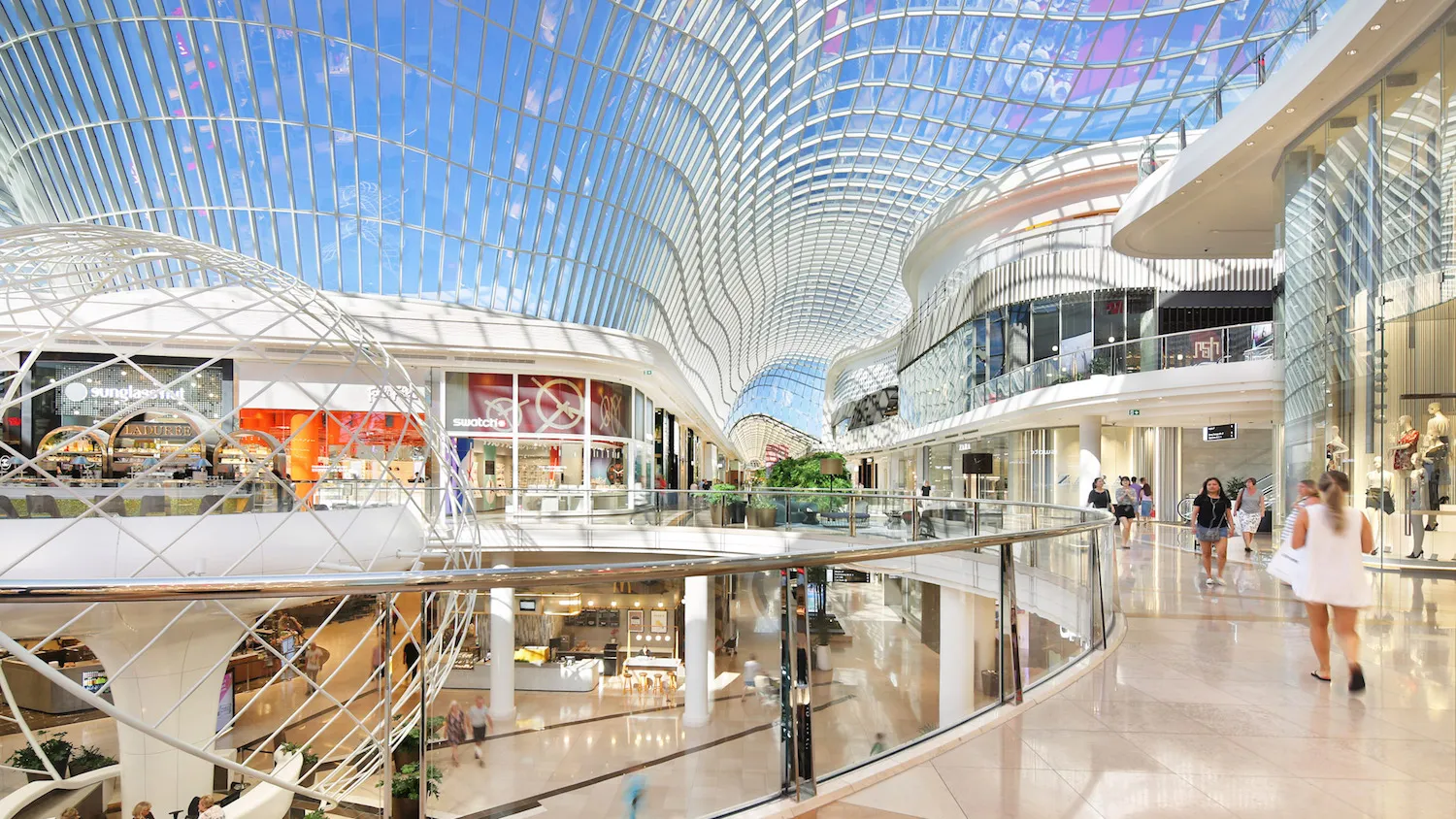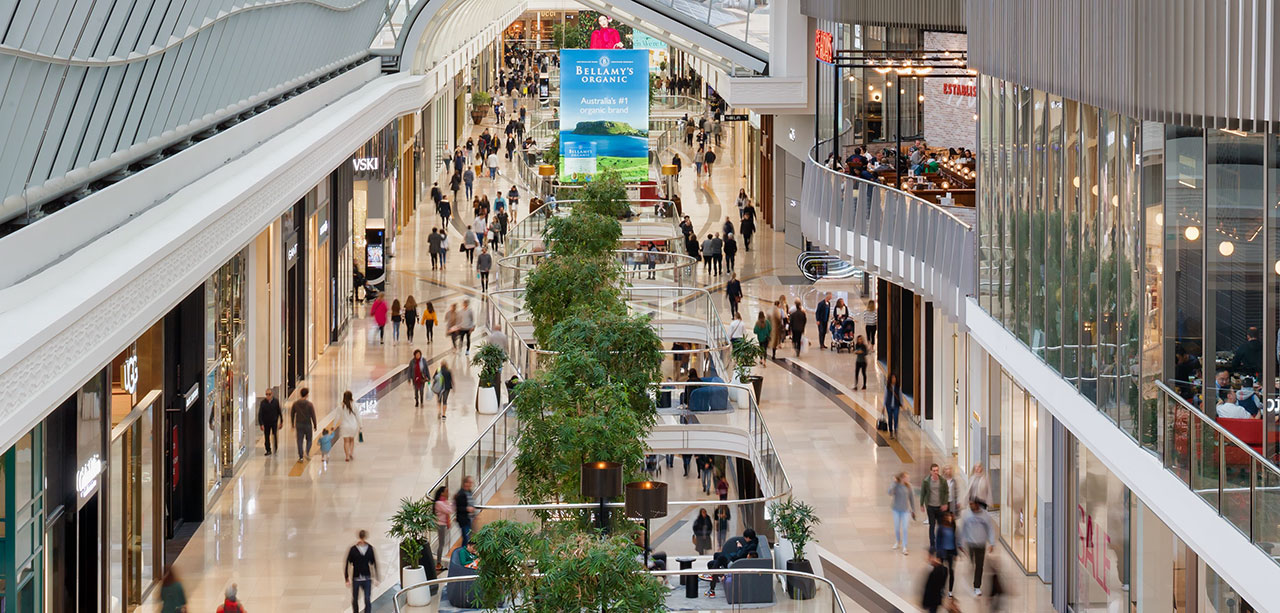Vicinity Gains 7% growth in FY22 Earnings but New Rents remain Lower
19 August 2022
Vicinity Centres delivered a 7.1% growth in earnings relative to FY21 despite continued disruption from COVID-related lockdowns in New South Wales (‘NSW’) and Victoria during 1H FY22 and the outbreak of Omicron from late December 2021.
Funds from Operations growth was driven by an 8.0% uplift in Net Property Income (‘NPI’) to $803 million, largely reflecting sustained strength of retail sales and improved negotiation outcomes with retailers, and therefore stronger than expected cash collections, rental growth, and improved ancillary income. This was partially offset by higher net interest costs, mainly due to the benefit of the swap reset in FY21 and increased corporate overheads, largely reflecting the one-off benefit of JobKeeper in FY21.
Mr Grant Kelley, CEO and Managing Director, said: “FY22 has been a positive year for Vicinity. Favourable retail trading conditions combined with strong operational execution and prudent financial stewardship, have underpinned an acceleration in our recovery as demonstrated by today’s results. After prolonged lockdowns in our two largest states of NSW and Victoria in 1H FY22, the retail sector has enjoyed a sustained rebound in retail sales and importantly, retailer confidence.”
Leasing spreads continued to show positive momentum, with the average leasing spread for FY22 at -4.8% relative to -6.4% in 1H FY22 and -12.7% in FY21.
Of all new leasing deals agreed in FY22, 71% were negotiated with fixed annual increases of 5% and cumulatively, 94% of all new deals were negotiated with fixed annual increases of at least 4%. Importantly, the fixed annual increases support current and future NPI growth. Furthermore, the average lease tenure of new deals negotiated in FY22 extended to 5.1 years, from 4.3 years in FY21.
The 1.6% or $233 million uplift in asset valuations (representing 5.1cps) for the six months to 30 June 2022 further demonstrate the resilient retail sector and the benefits of owning a diverse portfolio of assets. Notably, more than half of the valuation uplift was driven by income growth across a number of Vicinity’s flagship Premium, Outlet and Sub-regional centres.
Regional and Sub-regional assets continued to benefit from strong transactional evidence, while Outlet valuations continued to improve. Income growth and tightening capitalisation rates highlighted the ongoing strength of Vicinity’s Outlet portfolio and its resilience through cycles.
CBD asset valuations remained in line with 31 December 2021, reflecting steady leasing activity and improving re-leasing spreads, as sophisticated retailers consolidated store networks into Premium CBD centres. While the recovery is slower than the rest of the portfolio, the outlook for CBD retail is improving.
The Board declared a final distribution per security of 5.7 cents, bringing the full year distribution to 10.4 cents per security, representing a payout ratio of 95.3% of AFFO, within Vicinity’s target payout range. This compares to a full year distribution of 10.0 cents per security in FY21.
Gearing of 25.1% remains at the lower end of the target range of 25%-35%. Vicinity maintained its investment grade credit ratings of A/stable (S&P) and A2/stable (Moody’s).
Vicinity expects FY23 FFO per security to be in the range of 13.0 to 13.6 cents, AFFO per security to be in the range of 10.9 to 11.5cents and full-year distribution to be within Vicinity’s target range of 95-100% of AFFO.
Key Results
- FY22 results driven by strong operational execution and resilient retail sector
- Statutory net profit after tax (‘NPAT’) of $1,215m, up $1,473m
- Funds from operations (FFO) of $598m or 13.1cps
- Adjusted-FFO (‘AFFO’) of $496.8m or 10.9cps
- Final distribution of 5.7cps, bringing full year distribution to 10.4cps and representing a payout ratio of 95.3% of AFFO
- Robust balance sheet maintained, with low gearing of 25.1%, favourable weighted average maturity (‘WAM’) at 4.8 years and liquidity of $1.4b, as a result of capital management initiatives
- NTA of $2.36, up 10.3%, underpinned by strong FFO growth and 3.9% uplift in asset valuations, supported by income growth and transaction evidence
- Sustained rebound in retail sales and retailer confidence, notably in the second half of FY22 (‘2H FY22’), highlighting retail sector resilience
- Occupancy increased to 98.3% supported by strong leasing activity
- Progressed strategy by enhancing portfolio via strategic transactions, advancing retail and mixed-use development, and bolstering third party capital credentials
- In August 2022, Vicinity’s Board and joint venture partners approved the development of One Middle Road office and fresh food and dining projects at Chadstone
- FY23 FFO per security and AFFO per security expected to be in the range of 13.0 to 13.6 cents and 10.9 to 11.5 cents, respectively. Vicinity expects its full year distribution payout to be within its target range of 95-100% of AFFO
Portfolio performance
During FY22, Vicinity completed 1,378 leasing deals, 121 more deals than the prior year (FY21: 1,257).
After a moderation in leasing activity in January and February 2022, due to seasonality as well as the outbreak of Omicron, deal momentum accelerated with the number of deals completed in June 2022 being 49% higher than the number completed in June 2021.
Leasing spreads continued to show positive momentum, with the average leasing spread for FY22 at -4.8% relative to -6.4% in 1H FY22 and -12.7% in FY21.
Of all new leasing deals agreed in FY22, 71% were negotiated with fixed annual increases of 5% and cumulatively, 94% of all new deals were negotiated with fixed annual increases of at least 4%. Importantly, the fixed annual increases support current and future NPI growth. Furthermore, the average lease tenure of new deals negotiated in FY22 extended to 5.1 years, from 4.3 years in FY21.
Vicinity leased 374 vacant stores in FY22, and occupancy was 98.3% at the end of June 2022, representing a slight increase versus the 98.2% reported at 30 June 2021.
In addition to fulfilling its obligations imposed by the SME Codes until their expiration in March 2022, Vicinity continued to support small businesses and other retail partners in categories and locations most impacted by the pandemic, such as Food & Beverage, Travel and CBD locations.
COVID-19 lease variation negotiations with non-SME retail tenants continued to focus on driving mutual value and leasing outcomes which support retail partners experiencing hardship, while also reflecting the quality of Vicinity’s assets.
Vicinity’s highly targeted approach to negotiations preserved the weighted average lease expiry profile, improved leasing spreads and enhanced retailer mix across the portfolio.
Collection of gross rental billings averaged 91% for FY22, and 93% for 2H FY22. Of note, SME retail sales performance is broadly in line with non-SME specialty sales in FY22, which has further supported the collection of current and overdue rent. Cash collections from SME tenants improved from 66% of gross billings at 1H FY22 to 80% over FY22.
Vicinity expects to substantially complete all remaining lease variation negotiations with SME tenants by the end of 1H FY23, assuming there is no material deterioration in existing economic and COVID-related conditions.
Retail trading performance
On retail sales performance, Mr Kelley said, “The Australian retail sector has benefitted from elevated household savings and an extremely tight employment market. Consumers continued to show confidence and capacity to spend while maintaining a strong preference for physical store shopping.”
Customers continued to shop with purpose in FY22. While visitation was below 2019 levels, average spend per visit remained 1.3 times that recorded in 2019.
Higher spend per visit, combined with the introduction of on-trend retailers, and the particular success of luxury retail in Vicinity’s centres, supported total portfolio retail sales11 growth of 15.5% in 2H FY22 relative to the same period in 2019. Excluding CBDs, sales were 16.9% higher.
Despite four months of lockdown in 1H FY22, total portfolio moving annual turnover (MAT) was up 6.7%, with strong growth reported across mini majors and specialty stores. The key drivers were discretionary categories, including Jewellery, Apparel and Food Catering.
On tenant engagement, Mr Kelley added: “I am pleased to report that continued execution of our Retailer First program has been well received, with Vicinity increasingly being recognised as a partner of choice for growth-oriented retailers. Our national retailers ranked us number 1 on the retailer net promoter score, and number 2 overall across 10 retail landlords. As part of our Retailer First program, we have increased our focus on building strong, long-term relationships with our retailers, enhancing tenant experiences, and driving higher tenant retention.”
Progress on development pipeline
Vicinity is transitioning from planning to execution of its $2.9 billion retail and mixed-use development pipeline. The pipeline comprises projects which are expected to complete between FY23 and FY27, with approximately 85% of the development spend focused on six major mixed-use opportunities including Chadstone, Box Hill Central and Victoria Gardens in Victoria, Chatswood Chase Sydney and Bankstown Central in NSW and Buranda Village in Queensland.
During the year, Vicinity invested in a number of retail and mixed-use projects, including:
- Commenced Chadstone’s new Entertainment and Leisure precinct, expected to complete by end of FY23
- Remixed and upgraded the retail precinct in Box Hill Central South, including relocation of Coles from the northern site, the addition of new dual-frontage restaurants, a major ambience upgrade and reconfiguration of the mall
- Commenced the fresh food and mini majors precincts at Bankstown Central
- Completed modernisation program with extensive ambience upgrades at Mornington Central, including a new Woolworths and mix of specialty retailers
Mixed-use development projects in delivery during FY22 included:
- Upgrade and refurbishment of the Chadstone Place office, which is expected to complete in 4Q FY23, ahead of Officeworks’ head office relocation to Chadstone
- New A-grade office space over four levels in the southern precinct of Box Hill Central which is 100% leased to Hub Australia, expected to open in 3Q FY23
Subject to supportive market conditions, Vicinity expects development capex to increase to approximately $200-$250 million in FY23 and average approximately $300-$400 million per annum over the medium term.
Mr Kelley said, “Our development pipeline represents an exciting phase of growth for Vicinity. Importantly, given we own the land parcels earmarked for retail and mixed-use development, the pipeline is able to be flexed up and down in order to preserve the risk and return parameters of projects and the pace of capital deployment, thereby maintaining our strong balance sheet, credit ratings and disciplined approach to paying distributions.”
Sustainability
Sustainability is fundamental to the successful execution of Vicinity’s strategy and the long-term performance of its business. During FY22, Vicinity strengthened a number of its sustainability credentials across its Community Significance, Low Carbon Smart Assets and Climate Resilience pillars.
Once again, Vicinity improved its ranking in the Dow Jones Sustainability Index from 7th to 5th and was ranked Oceania Sector Leader and #3 globally in the Listed Retail Shopping Centre category by Global Real Estate Sustainability Benchmark (‘GRESB’). Also of note, Vicinity became a supporter of the Task Force on Climate-Related Financial Disclosures and published its second Modern Slavery statement as well as its second Innovate Reconciliation Action Plan.
Mr Kelley commented, “To date, Vicinity has made meaningful progress in sustainability, and we look forward to building on our strong credentials in FY23. Our approach to sustainability is anchored by our objective to drive value for all our stakeholders.”
Summary and outlook
In summary, Mr Kelley said, “FY22 was a year of recovery and progress at Vicinity. Our results highlight strong operational and financial execution in a recovering retail landscape, where consumers continued to show confidence and capacity to spend, and retailer confidence was robust.
“Our results also demonstrate that Vicinity remains the partner of choice for retailers who are looking for opportunities to grow. As we look ahead, Vicinity will continue to invest in its portfolio of assets to drive growth for both landlord and tenant.
“The strength of our balance sheet and our proactive approach to managing our capital provides us with the flexibility to navigate periods of uncertainty and at the same time, enables us to fund accretive investment opportunities, including our retail and mixed-use development pipeline.
“While we are mindful of inflation, rising interest rates and increased building costs, we are still seeing positive retail sales trends in our centres, and we cautiously anticipate a soft landing for the Australian economy over the next 12 to 18 months. Our asset portfolio is diverse in terms of asset type, location and retail mix which, as demonstrated during the pandemic, provides resilience to a range of possible outcomes.
“Vicinity is also relatively well positioned for a rising interest rate environment given our continued prudence with respect to fixed debt costs. Vicinity concluded FY22 with approximately 85% of its drawn debt hedged and approximately 80% of our drawn debt is hedged over FY23, with a very modest step down in FY24. We will maintain an active focus on hedging this year and in the years ahead.”
Guidance
Vicinity expects FY23 FFO per security to be in the range of 13.0 to 13.6 cents, AFFO per security to be in the range of 10.9 to 11.5cents and full-year distribution to be within Vicinity’s target range of 95-100% of AFFO.
“Adjusting for waivers and provisions written back in FY22, our FFO per security guidance for FY23 represents between 10% and 15% growth, which we expect to be driven by continued growth in rental and ancillary income and strengthening cash collections, partially offset by higher net interest costs.
“In closing, together with the Board and the Executive Leadership Team, I would like to acknowledge and thank everyone who is affiliated with Vicinity for their ongoing support, most especially our securityholders, retail partners, customers and of course the Vicinity team.”
Trading Chart
Disclaimer: The information contained on this web site is general in nature and does not take into account your personal situation. You should consider whether the information is appropriate to your needs, and where appropriate, seek professional advice from a financial adviser.



